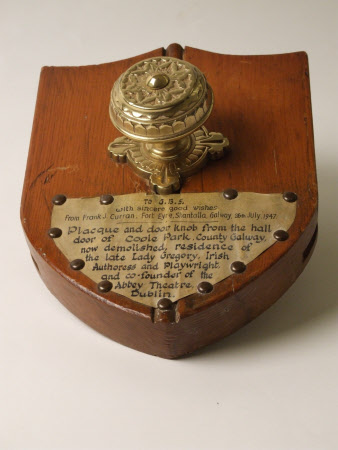Doorknob from Coole Park, the home of Lady Augusta Gregory
Category
Brassware
Date
Unknown
Materials
Brass, wood and paper
Measurements
11.5 ins (h)8.75 ins (w)1.75 ins (d)3 ins (h)3 ins (dia)
Order this imageCollection
Shaw's Corner, Hertfordshire
NT 1275073
Summary
Wooden plaque and brass doorknob from the hall door of Coole Park, County Galway, (now demolished), residence of Lady Gregory (1852-1932), Irish dramatist and co-founder of the Abbey Theatre, Dublin. Lady Gregory was very close to both Bernard and Charlotte Shaw.The brass doorknob: the top moulded with a flower head, spreading to a four-pointed circle at base. Mounted on a plaque in the form of a wooden shield, grooved on the sides. A paper label with inscription fixed to the lower half with upholstery nails.In black ink on label "TO G.B.S. / with sincere good wishes / from Frank J. Curran, Fort Eyre, Shantalla, Galway, 26th July, 1947. / Placque (sic) and doorknob from the hall / door of Coole Park, County Galway, / now demolished, residence of / the late Lady Gregory, Irish / Authoress and Playwright,/ and co-founder of the / Abbey Theatre,/ Dublin."
Full description
Lady Augusta Gregory (1852-1932) was one of the most important figures in Irish Theatre in the late 19th and early 20th centuries. Her home at Coole Park in County Galway, Ireland, became a meeting place for many of the leading writers in the Irish Literary Revival, including W.B. Yeats. The Shaws stayed with her there on many occasions, and Shaw took photographs of their holidays in this special place. Lady Gregory visited Shaw’s Corner several times over the years, and remembered her stays with much fondness: ‘warm and bright with fires in every room and pots of chrysanthemums’. Shaw also took photographs of Lady Gregory in the garden at Shaw’s Corner (NT 1715397). Many of her books and other writings can be found in the Shaws’ library. And a portrait of her hangs nearby (NT 1274692). Together with Yeats, Lady Gregory founded the Irish Literary Theatre and the Abbey Theatre in Dublin, writing many works for both. Lady Gregory and Yeats asked Shaw for a play for their new theatre, and he responded with his comedy about Ireland John Bull’s Other Island (1904). After Lady Gregory died, the Irish State demolished her house at Coole Park in 1941. The doorknob from the hall door of Coole Park was presented to Shaw as a memento on his birthday in 1947 by Frank Curran of Galway. A photograph of the doorknob is reproduced in Shaw, Lady Gregory and the Abbey (eds. Dan Laurence and Nicholas Grene, 1993, Plate 11). (Alice McEwan, 2020)
Provenance
Presented to Bernard Shaw by Frank J. Curran, Fort Eyre, Shantalla, Galway, 26th July, 1947. The Shaw Collection. The house and contents were bequeathed to the National Trust by George Bernard Shaw in 1950, together with Shaw's photographic archive.
Marks and inscriptions
In black ink on label "TO G.B.S. / with sincere good wishes / from Frank J. Curran, Fort Eyre, Shantalla, Galway, 26th July, 1947. / Placque (sic) and doorknob from the hall / door of Coole Park, County Galway, / now demolished, residence of / the late Lady Gregory, Irish / Authoress and Playwright,/ and co-founder of the / Abbey Theatre,/ Dublin."

